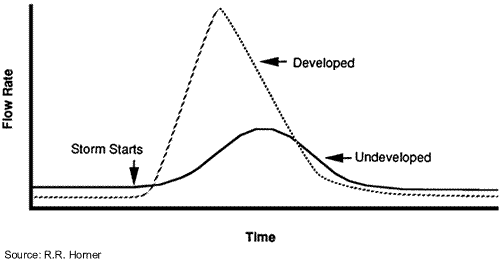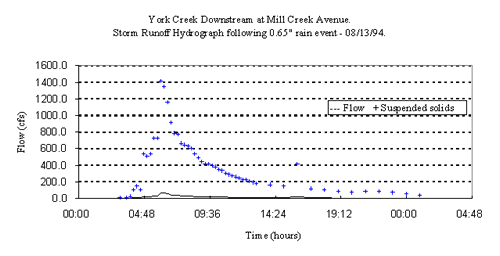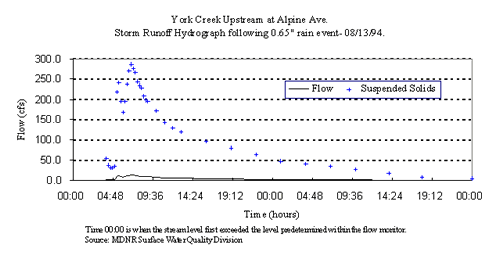York Creek Management Plan - Stormwater Runoff/Steam Hydrology



3.1 Stormwater Runoff/Stream Hydrology
One of the most serious water quality problems in York Creek is actually a water quantity problem. The volume of water reaching the stream, and the velocity of that water once in the stream, increases dramatically with the addition of impervious surfaces associated with the process of urbanization. Peak flows in urbanized streams occur sooner, are of greater volume and velocity, and are of shorter duration. (Leopold, Luna. 1968. Hydrology for urban planning - a guidebook on the effects of land use. U.S. Geological Survey Circular 554.) Figure 13 compares hydrologic tendencies of developed and undeveloped watersheds.
Figure 13. Hydrograph Patterns Typical of Developed and Undeveloped Watersheds.
This pattern of higher, faster peak flows is certainly true of York Creek and its tributaries following the rate of development there in recent years. One result of these increased, sporadic flows is the possible displacement of young fish from the stream. (Harvey, Bret C. 1987. Susceptibility of young-of-the-year fishes to downstream displacement by flooding. Transactions of the American Fisheries Society. 116:851-855.) The control of stormwater runoff from these developed areas is of utmost importance to the return of York Creek to a stream capable of supporting trout.
Several forms of flow data were assembled during this study. Included in these are monthly exceedance flows. A 50 percent exceedance flow means that flows are greater than the stated value 50 percent of the time. Exceedance values as determined by MDNR for York Creek are found in Table 3.
Table 3. Monthly Exceedance Flows (cfs) - York Creek
Jan
Feb
Mar
Apr
May
Jun
Jul
Aug
Sep
Oct
Nov
Dec
50% 1.5 1.6 3.3 3.3 1.4 1.4 1.1 1.0 1.0 1.2 1.5 1.5
95% 0.9 1.0 1.3 1.5 1.0 0.8 0.7 0.6 0.7 0.8 0.9 0.9
Mean 1.8 1.9 4.4 4.2 1.9 1.6 1.2 1.2 1.4 1.5 1.6 1.7
(Exceedance flows are estimated by MDNR Land and Water Management Division and represent flow estimates at the mouth of York Creek.)
The problems related to increases in runoff volume and velocity are often compounded by the content of that runoff. It is believed that pollutant concentrations are highest just before and during the peak flow. During the initial stages of a runoff event, known as the first flush, pollutants within the stormwater conveyance system are transported to the stream. Included in this concentrated flush are the NPS pollutants which have accumulated since the last rain event. When the initial runoff from a rain event propels, or flushes, the accumulated material downstream, it is often in a concentrated state . (Novotny, Vladimir. 1991. Urban diffuse pollution: sources and abatement. Water Environment and Technology. December, 1991:60-65.)
The first half inch of runoff is generally referred to as the first flush. (Chang, George C., J.H. Parrish, and C. Soeur. 1990. The first flush of runoff and its effects on control structure design. City of Austin. Environmental and Conservation Services Department. Austin, Texas.) The runoff in the York Creek watershed generates extreme hydrologic fluctuations that can cause extensive damage to the middle and lower reaches of the stream through accelerated streambank erosion and inordinate quantities of sediment deposition in areas of lesser velocity in the stream. This situation requires that implementation measures related to stormwater runoff be considered before those related to instream activities.
The first flush phenomenon was found to exist in York Creek, as evidenced by Figures 14 and 15. The concentration of suspended solids was found to peak within minutes of the peak flow. The figures are typical of stream conditions in York Creek during a variety of rain conditions. The receiving waters of a stream, in this case the Grand River, are also adversely affected by those concentrated sediments and other NPS pollutants.
Selection, design, and implementation of best management practices (BMPs) are often keyed to the first flush or first half inch of rainfall. However, it is not always a consistent means to determine runoff from all ranges of imperviousness. It has been suggested that a better BMP sizing rule is to size the basins based on the runoff produced by a larger storm using a runoff coefficient, or the ratio of runoff to rainfall. ( Schuler, Thomas, editor. 1994. First flush of stormwater pollutants investigated in Texas. Watershed Protection Techniques. 1(2):88-89.) Furthermore, in the York Creek watershed, there exist many areas within the designated sub-basins that have markedly higher levels of imperviousness than the entire sub-basin. The first flush from these individual areas likely carries even higher concentrations of pollutants. An example of this scenario is in the area along Alpine Avenue that drains into the Alpine-Walker Drain.
The factors related to the first flush phenomenon in York Creek are augmented by past channelization efforts. Stream channelization further serves to maintain unnaturally elevated velocities, especially during the conveyance of stormwater runoff. When compared to flows in a natural, meandering stream system, water flowing through channelized stretches travels a lesser linear distance while accounting for the same change in elevation. Channelization increases slopes, and in turn, velocities. Currently several sites in the channelized stretches are being eroded, due at least in part to the elevated velocities of York Creek.
It is believed that proper stormwater management efforts (including retrofitting existing stormwater controls), used in conjunction with erosion and sedimentation controls, will decrease the impacts of first flush, both by decreasing peak flows and the concentration of pollutants suspended in those flows.
Figure 14.
Figure 15.
